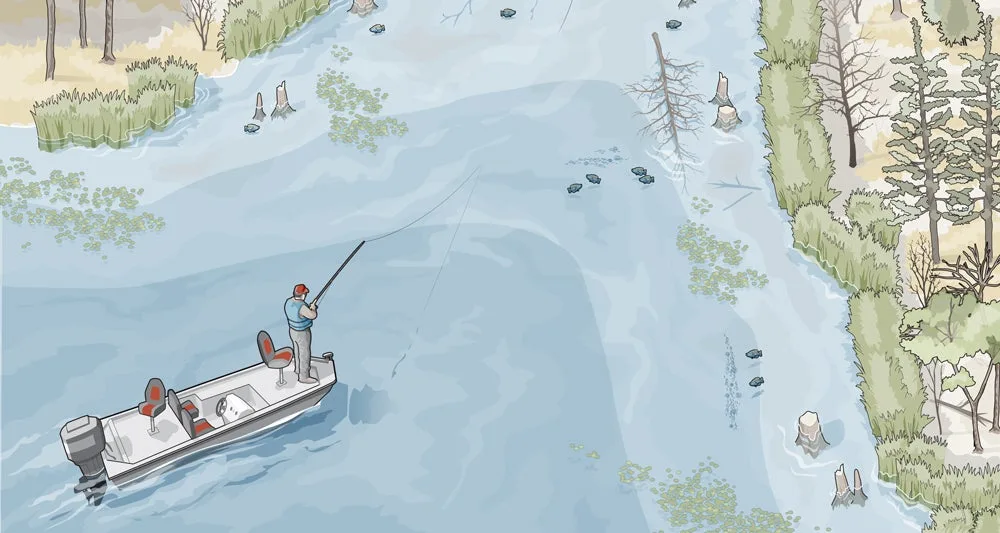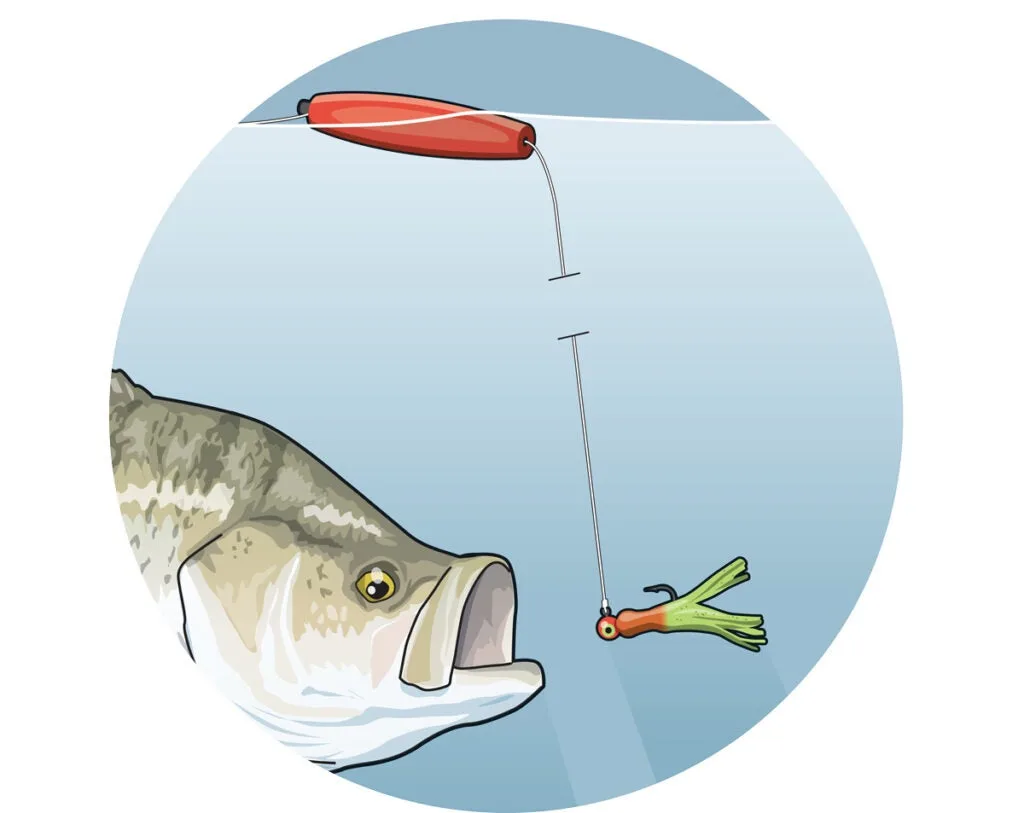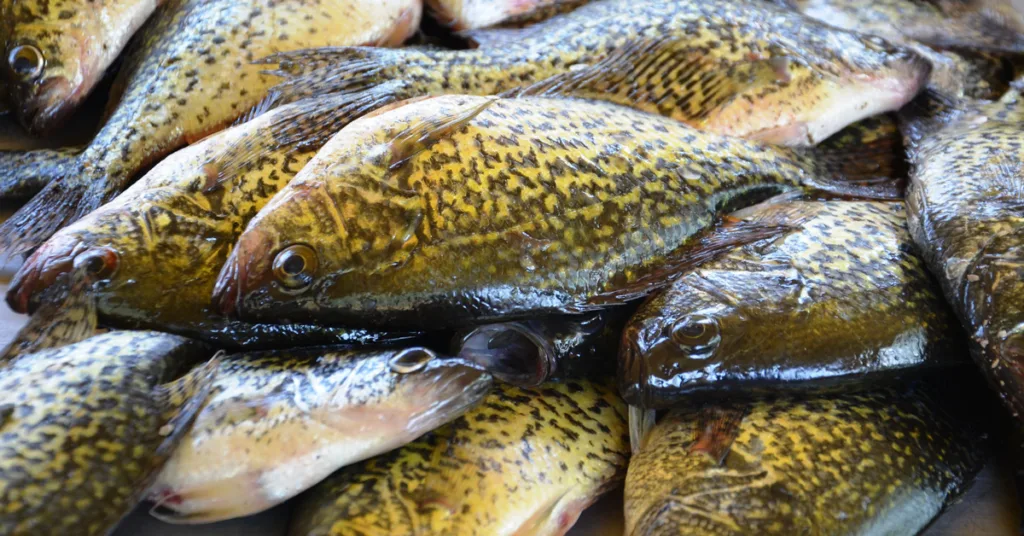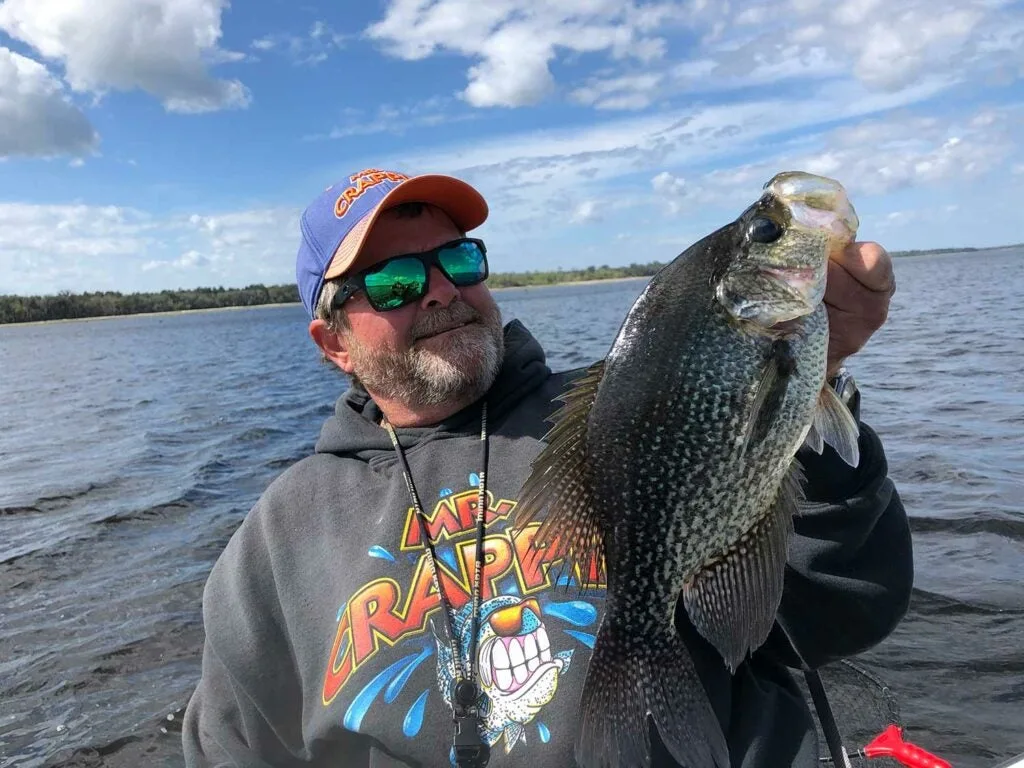We may earn revenue from the products available on this page and participate in affiliate programs. Learn more ›
Crappie are one of the most popular gamefish in the U.S.—and for good reason. They’re fun to catch for anglers of any skill level, put up a good fight, and can grow to impressive sizes. If you don’t believe us, just check out these world-record crappie. They are also excellent table fare, and a full limit can provide for a delicious fish fry. Not to mention, these panfish can be caught all over the country.
With a few tips and tactics, you can start catching crappie year-round. We put together this everything-you-need-to-know guide to targeting crappie from spring to fall and then through the ice in the winter. Here’s how to get started.
How to Catch a Crappie: Table of Contents
Crappie Fishing in the Spring
Factors and Gear to Consider
How to Catch Crappie in the Summer
How to Catch Crappie in the Fall
Crappie Fishing in the Winter
How to Catch Crappie in (Almost) Any Weather Conditions
FAQs
Crappie Fishing in Spring

For the panfish angler, spring might as well be Christmas. Every year, hordes of crappie flock to the shallows to spawn. In the Northern states, this happens a month or so after ice-out or even during the last of the hard-water season. In the South the migration starts as early as February. Regardless of when it begins, anglers have a big window to target huge concentrations of fish during the pre-spawn feeding frenzy. Here’s what you need to know.
Factors and Gear to Consider
Water Temperature
No tool is more essential for success in spring than knowing the water temperature. Crappie migrate to the shallows once the water rises above 50 degrees, and they spawn when it’s well into the 60s. If you’re reading anything between 50 and 65, it’s a good time to hit the water.
Use Light Tackle for Spring Crappie
There’s no room in this game for anything except light or ultralight tackle to present tiny lures properly and to detect subtle hits. Small 500- to 1000-size reels with 4-pound-test line matched with a 6-foot ultralight rod will do the trick.
The Best Lures for Spring Crappie

Presentation is critical, as pre-spawn crappie are often at specific depths and keyed into a particular forage. Small tubes and jigs can be fished as is or beneath a small fixed Comal Tackle cigar float to keep them eye-level with the fish. Try vertical-jigging these lures when crappie are holding deeper, and switch to the float as they move into the shallows.
Along with small tubes and jigs, small, suspending minnow baits also work great on early-season crappie. They can be worked slowly and kept in the strike zone; crappie may still be sensitive to cold water and not willing to move too far or fast to chase a lure. (For more on crappie bait, check out our picks for the best crappie lures.)
Fish in Shallow Water
As the water gets warm, crappie will keep pushing into shallower water. When your gauge reads in the low to mid-50s, fish flats that are between 5 and 10 feet deep. Once it hits the 60s, any part of the lake that has 18 inches to 3 feet of water will hold fish.
Locate Schools of Baitfish
Structure such as brushpiles and contour changes are key when you’re searching for pre-spawn crappie, which will use these areas as cover. But nothing is more important to them right now than finding food. Locate bait schools with your electronics. Shallow flats that hold bait in spring will likely have pre-spawn crappie not far behind. Look for flats adjacent to the main lake, particularly on the northern side, which will warm up quicker.
How to Catch Crappie in the Summer
Remember how awesome the crappie fishing was during the spring? The fish were spawning, bunched in the shallows thicker than fleas on a hound. You were catching slabs off stake beds and brush piles in every bay, cove, and flat. Then suddenly, just like somebody pulled the plug, it was over. Now you’re figuring it’s time to stash the crappie tackle until next spring.
Hold on. Even though the spawning bonanza has passed, there’s still plenty of great crappie action out there if you change your tactics. After the spawn, crappie follow submerged creek channels out of reservoir tributary arms toward the main bodies of lakes. Although they’re unlikely to be packed together now as they were during the spawn, they’re still in predictable places and respond eagerly to live bait and lure presentations. Here’s how to find these summer hangouts.
Use Crankbaits
When lake temperatures reach about 75 degrees, postspawn crappie will be scattered along the first dropoff they encounter adjacent to their bedding areas—12 to 18 feet deep is typical. These fish will be suspending now rather than holding tight to the bottom, so your best approach is to cover a lot of water by slow-trolling small crankbaits like the Bandit 100 and Bomber Model A. Target the deep ends of gravel flats, major points at tributary mouths, and creek-channel drops.
First scan these areas with your sonar and put marker buoys along channels and ditches to chart your route. Using soft-action baitcasting rods and 8-pound abrasion-resistant line, troll between 1.5 and 2.5 mph in a lazy S pattern, alternately sweeping the open water over the channel and banging bottom on top of the drop with your lures. When a fish strikes, don’t grab the rod and set the hook. A hard hookset may rip out the hook. Instead, pick up the rod and just start reeling. Don’t forget to take along a plug knocker to retrieve crankbaits that hang up in brushy cover.
Probe Channel Cover for Post-Spawn Crappie
With the lake topping 80 degrees, crappie will most often be hanging around deep creek and river channels. Look for them to be suspending near, or holding tight to, stumps, brush piles, and flooded standing timber adjacent to channels in 20 to 30 feet of water. Mark channel drops with buoys, then probe for crappie using a Kentucky rig (which basically consists of a bell sinker at the end of the main line with two dropper hooks above). Use cheap 30-pound mono as leaders off of the main line. The stiff, springy leaders will keep the two baits—whether you’re using minnows, jigs, or tube baits—from tangling. A bow-mounted sonar with the transducer attached to the trolling motor will help you stay on target. Lower the sinker straight down into the bottom cover and slowly reel it up, repeating as you progress along the channel. July crappie often suspend in a tower formation, and this presentation will catch fish from 30 to 10 feet deep.
Drag Offshore Humps for Summer Crappie
Even if lake temperatures exceed 90 degrees, you can still catch crappie by keying on offshore humps (submerged islands). Target those no shallower than 15 feet on top, especially if they rise out of deep water near a flowing channel. Crappie gravitate to the peak of the hump to feed on baitfish when current is being generated from the upstream dam, then they drop back to suspend off its deep sides once the turbines shut down.
Idle over the structure, marking it with buoys. Move to open water, let out about 40 feet of line with a Kentucky rig on the business end, and head back to the spot with your trolling motor, dragging the rig behind your boat. When you move across the hump and feel the sinker hit bottom, speed up slightly; if you haven’t felt the sinker drag for several seconds, slow down until you do.
Crappie suspending in hot water can be maddeningly slow to bite. When you spot a school on your sonar, you may have to approach it a few times from several different directions to entice a strike. A sudden change of speed can also trigger a bite. As the rig passes near the school, either speed up your trolling motor to quicken the presentation, or kill it so the rig sinks. Find the right combination, and you can get two hookups at once.
How to Catch Crappie in the Fall

For many crappie fishermen, the only good thing about autumn is hunting season. They use cold fronts, reservoir drawdowns, and lethargic fish as excuses to trade their rods for bows or rifles. But you can still catch slabs this time of year, and veteran Tennessee guide Jim Duckworth can show you how to catch crappie. Here are his favorite fall tactics.
Tube Tricks for Fall Slabs
“Many Sunbelt reservoirs are lowered 5 to 15 feet in fall in anticipation of heavy winter and spring rains,” Duckworth says. “The drawdown forces shallow baitfish to relocate to steep riprap banks, where they feed on algae that coats the rocks. Hungry crappie gorge on these minnows.” He loads the boat by casting a 1 1⁄2-inch Berkley PowerBait Atomic Tube, rigged on a 1⁄8-ounce Blakemore Road Runner jig spinner, to the rocks with a light spinning outfit.
Fall Crankbait Tactics for Crappie
“A creek-channel dropoff bordering a shallow flat is also a likely place to find crappie now. They’ll scatter out over the channel after a cold front, then gang up along the drop to feed on passing bait schools.” Troll a 200-series Bandit crankbait on a soft-action bass cranking rod with 20-pound braided line at 2 to 3 mph. “Motor tight to the dropoff in a lazy S route,” says Duckworth, “so the lure ticks the outer edge of the shallow flat and then swims into the deeper channel.”
Use Spoons
“By the time the leaves fall and the lake’s surface temperature has dropped below 60 degrees, crappie will be fattening up on shad,” says Duckworth. “Use your fishfinder to locate baitfish schools suspending off points at the mouths of reservoir creeks, then jig a 1⁄2-ounce spoon just above the school. Rig the spoon on a 6-foot medium-action spinning outfit with 20-pound braid and a 2-foot fluorocarbon leader.” The bites will be anything but subtle.
Crappie Fishing in the Winter
During the hard-water season, everyone loves to wake up to an unseasonably warm air mass, near normal barometer, light wind, and bearable precipitation. Too bad that combination of conditions comes around so rarely. When Mother Nature throws a curveball on the day you plan to crappie fish, you have to make the call between toughing it out or sitting at home. Since no one really wants to do the latter, we spoke with an expert crappie fishing guide to see how he keeps the rods bent during the toughest conditions on the ice. His tips and tricks can teach you how to catch crappie all winter long.
How to Icefish for Crappie in a Blizzard
If the news is calling for a blizzard, the average ice angler is staying home. Kloet says that’s a huge mistake. Crappie and other panfish actually get very aggressive before and during a storm; you just have to know where to find them. According to crappie fishing guide Doug Kloet, crappie stay deep for most of the winter, sitting just off the bottom in 20 to 22 feet of water. As a storm moves in, however, the fish will move up in the water column, suspending as shallow as 5 or 10 feet. If you didn’t know to make that depth adjustment, you’d be fishing below the fish.
Kloet takes advantage of the crappie’s pre-blizzard aggression by upsizing his baits. Three-inch Rapala Jigging Raps are his favorite, but he notes that it’s essential to use light 2- or 3-pound monofilament to detect subtle bites and avoid line twist. Kloet likes to tip his Jigging Rap with a fathead-minnow head, as crappie are attracted to both the eyes and the scent it exudes. “Suspending crappie will almost always be stacked on top of each other,” he says. “Once we find them, we stay put.”
After the storm rolls in, fish are less likely to suspend in the water column and will move around with the baitfish. “Once you’re into the blizzard, they’ll be on the go,” Kloet says. He stays with the fish by drilling more holes but never ventures far from his starting point. The all-out blitz may be over, but the crappie will remain active until the storm’s end. Kloet downsizes to a Northland Mud Bug tipped with a spike during the blizzard; the smaller jig elicits more strikes when the crappie gets a bit more selective.
How to Catch Crappie in (Almost) Any Weather

Crappie Tips for When It’s Hot and Muggy
Minnows fade quickly in the heat, so switch to tube baits. Look for towers of suspending fish at dropoffs down to 30 feet and probe them vertically with a Kentucky rig.
How to Catch Crappie in Windy Conditions
Wave action creates cloudy water perfect for ambushes, and crappie emerge from channels to prey on bait feeding on windblown plankton. Head to banks with nearby dropoffs and slowly swim a small white or chartreuse twister jig.
Fishing for Crappie When It’s Bright and Sunny
Under clear skies, crappie retreat from piercing UV light in brushy cover near channel drops. Fish straight down into the thick stuff with a Kentucky rig.
How to Fish for Crappie When a Front Is Coming
Before a storm, crappie school up to bird-dog wandering baitfish. Make multiple passes over channel drops until you find them on your graph, then troll crankbaits or slow-drift jigs through the school.
FAQs
Q: What time of day do crappie bite best?
Crappie feed in low light, so the best times to fish are at dawn and dusk. During colder times of year, though, try fishing during the warmest time of the day.
Q: What is the best depth to catch crappie?
This varies depending on the time of year and water temperature. A good general rule during the pre-spawn and spawning season is to go for 5- to 10-foot-deep water when the water temperatures are in the 50s and 18 inches to 3 feet deep when temps hit the 60s.
Q: What’s the best live bait for crappies?
Crappies will go for wax worms, crappie minnows, golden shiners, freshwater shrimp maggots, and more.





